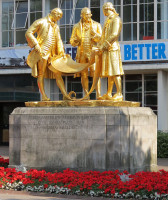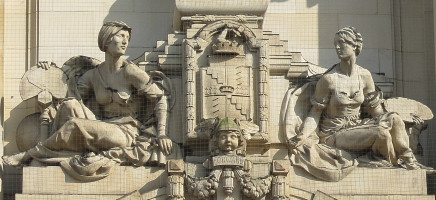 William Bloye's Boulton, Watt and Murdoch group.
William Bloye's Boulton, Watt and Murdoch group.
 William Bloye's Boulton, Watt and Murdoch group.
William Bloye's Boulton, Watt and Murdoch group.
Near to the Birmingham Hall of Memory, and the Statue of King Edward VII, just along Broad Street is the group of Matthew Boulton, James Watt and William Murdoch, pioneers of steam among much else. The sculptor is William Bloye, and the date 1939. The three men are shown standing in a conversational group, two – Watt to the left as we look at the group, and Murdoch on the right – holding several sheets of engineering drawings, and the one in the middle – Boulton – gesturing with an open hand. They wear waistcoats and outer heavier coats to knee length, with many buttons at the front and around the cuffs.
Statues of this date are not so common. By 1939 we are past the end of Art Deco, and figural and representational sculpture was on the ebb, and so it is interesting to see that here we have clearly representational figures, with some effort given to the detail of face and hands. However, although the clothing is contemporary, the modern tendency is evident in the rather sketchy surface and lack of interest in the falls of the drapery. The statues are brightly gilt, which again, for a group of this type all on its own, would have been considered unusual at an earlier time. There is no attempt at monumentalism or grandeur, as there would have been in earlier times, and there is a certain bulge to the stomach of each figure which deviates somewhat from both the athletic and the ascetic ideal figure. In terms of composition, however, seen from directly in front, there is a symmetry to the group, in the clothing, coats, and broadly in the poses of the outer figures, with variation given in the details and the placing of the hands.
The sculptor William Bloye (1890-1975) was trained at Birmingham at the School of Art, for a short period under George Frampton, and and under Eric Gill. He lived and worked in the city, and himself taught at the School of Art until 1956. He became a Fellow of the Royal Society of British Sculptors in 1938, and was associated with the Royal Birmingham Society of Artists, being at one time their vice-President, but never succeeded in being elected to the Royal Academy. Towards the end of his life he moved to Italy. His work is fairly widespread within Birmingham and the Midlands, but not in the south of England. The Boulton, Watt and Murdoch group is his most significant public work, and most of his productions are relief sculptures, often quite minor, and typically visibly modern. A welcome exception is his early work, the group on the rear of the Birmingham Museum and Art Gallery, most conveniently seen from across Great Charles Street – this looks to be greatly influenced by his Edwardian master, Frampton. He also was responsible for recasting Thomas Brock’s statue of Queen Victoria in Victoria Square, losing much in the features of the face. For an example of his more modern figural work in Birmingham, at 7 Waterloo Street is the Legal and General Building, with seven panels in a spare, Deco style, with over-large hands and lacking in detail.
Bloye's group of Art and Science, rear of Birmingham Museum and Art Gallery.
Birmingham Hall of Memory // and Statue of Edward VII // Other Birmingham sculpture // Sculpture in England // Sculpture pages
Visits to this page from 10 Nov 2014: 6,284